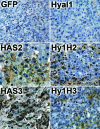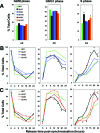Spontaneous metastasis of prostate cancer is promoted by excess hyaluronan synthesis and processing
- PMID: 19218337
- PMCID: PMC2665762
- DOI: 10.2353/ajpath.2009.080501
Spontaneous metastasis of prostate cancer is promoted by excess hyaluronan synthesis and processing
Abstract
Accumulation of extracellular hyaluronan (HA) and its processing enzyme, the hyaluronidase Hyal1, predicts invasive, metastatic progression of human prostate cancer. To dissect the roles of hyaluronan synthases (HAS) and Hyal1 in tumorigenesis and metastasis, we selected nonmetastatic 22Rv1 prostate tumor cells that overexpress HAS2, HAS3, or Hyal1 individually, and compared these cells with co-transfectants expressing Hyal1 + HAS2 or Hyal1 + HAS3. Cells expressing only HAS were less tumorigenic than vector control transfectants on orthotopic injection into mice. In contrast, cells co-expressing Hyal1 + HAS2 or Hyal1 + HAS3 showed greater than sixfold and twofold increases in tumorigenesis, respectively. Fluorescence and histological quantification revealed spontaneous lymph node metastasis in all Hyal1 transfectant-implanted mice, and node burden increased an additional twofold when Hyal1 and HAS were co-expressed. Cells only expressing HAS were not metastatic. Thus, excess HA synthesis and processing in concert accelerate the acquisition of a metastatic phenotype by prostate tumor cells. Intratumoral vascularity did not correlate with either tumor size or metastatic potential. Analysis of cell cycle progression revealed shortened doubling times of Hyal1-expressing cells. Both adhesion and motility on extracellular matrix were diminished in HA-overproducing cells; however, motility was increased twofold by Hyal1 expression and fourfold to sixfold by Hyal1/HAS co-expression, in close agreement with observed metastatic potential. This is the first comprehensive examination of these enzymes in a relevant prostate cancer microenvironment.
Figures






References
-
- Pienta KJ, Smith DC. Advances in prostate cancer chemotherapy: a new era begins. CA Cancer J Clin. 2005;55:300–318. - PubMed
-
- Fraser JR, Laurent TC, Laurent UB. Hyaluronan: its nature, distribution, functions and turnover. J Intern Med. 1997;242:27–33. - PubMed
-
- Stern R. Hyaluronan metabolism: a major paradox in cancer biology. Pathol Biol (Paris) 2005;53:372–382. - PubMed
-
- Toole BP. Hyaluronan promotes the malignant phenotype. Glycobiology. 2002;12:37R–42R. - PubMed
-
- Toole BP. Hyaluronan: from extracellular glue to pericellular cue. Nat Rev Cancer. 2004;4:528–539. - PubMed
Publication types
MeSH terms
Substances
Grants and funding
LinkOut - more resources
Full Text Sources
Medical

